Dielectric Properties of Wood-Polymer Composites: Effects of Frequency, Fiber Nature, Proportion, and Chemical Composition
Abstract
1. Introduction
2. Theoretical Background
3. Materials and Methods
4. Results and Discussion
4.1. Effects of Frequency and Fiber Content
4.2. Effect of the Fiber Chemical Composition on the WPC Chemical Composition
5. Practical Implications
6. Conclusions
- Increasing the proportion of fibers in WPCs increases the dielectric constant, the loss factor, and the loss tangent.
- The variation in WPC resistivity as a function of frequency is not significant beyond 10 MHz. Thus, the addition of wood fibers does not modify the resistive nature of HDPE. Therefore, WPCs have the potential for electrical insulation applications in the high-frequency range.
- The difference in the chemical properties of fibers explains the variations in the dielectric constant of composites reinforced with wood fibers from different species. Indeed, fibers with high cellulose contents have higher dielectric constant values.
Author Contributions
Funding
Acknowledgments
Conflicts of Interest
References
- Bledzki, A.K.; Gassan, J. Composites reinforced with cellulose based fibers. Prog. Polym. Sci. 1999, 24, 221–274. [Google Scholar] [CrossRef]
- Bledzki, A.K.; Gassan, J.; Theis, S. Wood-filled thermoplastic composites. Mech. Comp. Mat. 1998, 34, 563–568. [Google Scholar] [CrossRef]
- Bledzki, A.K.; Reihmane, S.; Gassan, J. Thermoplastics reinforced with wood fillers: A literature review. Polym. Plas. Technol. Eng. 1998, 37, 451–468. [Google Scholar] [CrossRef]
- Ashori, A. Wood-plastic composites as promising green-composites for automotive industries! Biores. Technol. 2008, 99, 4661–4667. [Google Scholar] [CrossRef]
- El-Meligy, M.G.; El-Zawawy, W.K.; Ibrahim, M.M. Lignocellulosic composite. Polym. Adv. Technol. 2004, 15, 738–745. [Google Scholar] [CrossRef]
- Maldas, D.; Kokta, B.V.; Raj, R.G.; Sean, S.T. Use of wood fibers as reinforcing fillers for polystyrene. Mat. Sci. Eng. 1988, A104, 235–244. [Google Scholar] [CrossRef]
- Raj, R.G.; Kokta, B.V.; Daneault, C. Wood flour as a low-cost reinforcing filler for polyethylene: Studies on mechanical properties. J. Mat. Sci. 1990, 25, 1851–1855. [Google Scholar] [CrossRef]
- Stokke, D.D.; Gardner, D.J. Fundamental aspects of wood as a component of thermoplastic composites. J. Vinyl Addit. Technol. 2003, 9, 96–104. [Google Scholar] [CrossRef]
- Takatani, M.; Ito, H.; Ohsugi, S.; Kitayama, T.; Saegusa, M.; Kawai, S.; Okamoto, T. Effect of lignocellulosic materials on the properties of thermoplastic polymer/wood composites. Holzforschung 2000, 54, 197–200. [Google Scholar] [CrossRef]
- Bogoeva-Gaceva, G.; Avella, G.; Malinconico, M.; Buzarovska, M.; Grozdanov, A.; Gentile, G.; Errico, M.E. Natural fiber eco-composites. Polym. Comp. 2007, 28, 98–107. [Google Scholar] [CrossRef]
- Notingher, P.V.; Stancu, C.; Enescu, I.; Enescu, A. Dielectric Properties of Wood-Polymer Composites. Mater. Plast. 2010, 47, 393–398. [Google Scholar]
- Dhal, J.P.; Mishra, S.C. Processing and Properties of Natural Fiber-Reinforced Polymer Composite. J. Mater. 2013, 1–6. [Google Scholar] [CrossRef]
- Markiewicz, E.; Paukszta, D.; Borysiak, S. Acoustic and Dielectric Properties of Polypropylene-Lignocellulosic Materials Composites, Polypropylene, Fatih Dogan, IntechOpen. 2012. Available online: https://www.intechopen.com/books/polypropylene/acoustic-and-dielectric-properties-of-polypropylene-lignocellulosic-materials-composites (accessed on 24 May 2021).
- Azlan, A.A.; Badrun, M.K.A.; Ali, M.T.; Awang, M.Z. A study of dielectric constant and loss tangent of leucaena leucocephala wood plastic composite (WPC) substrate. In Proceedings of the 2013 IEEE Symposium on Wireless Technology and Applications (ISWTA), Kuching, Malaysia, 22–25 September 2013; pp. 176–181. [Google Scholar] [CrossRef]
- Akram, M.; Javed, A.; Rizvi, T.Z. Dielectric properties of industrial polymer composite materials. Turk. J. Phys. 2005, 29, 355–362. [Google Scholar]
- Porebska, R.; Rybac, A.; Kozub, B.; Sekula, R. Polymer matrix influence on stability of wood polymer composites. Polym. Adv. Technol. 2015, 26, 1076–1082. [Google Scholar] [CrossRef]
- Impedance Measurement. Available online: https://www.novocontrol.de/php/intro_imp_spectr.php (accessed on 23 May 2021).
- Migneault, S.; Koubaa, A.; Perré, P. Effect of Fiber Origin, Proportion, and Chemical Composition on the Mechanical and Physical Properties of Wood-Plastic Composites. J. Wood Chem. Technol. 2014, 34, 241–261. [Google Scholar] [CrossRef]
- ASTM D4703-03. Standard Practice for Compression Molding Thermoplastic Materials into Test Specimens, Plaques, or Sheets; ASTM International: West Conshohocken, PA, USA, 2003. [Google Scholar]
- Augustine, P.; Kuruvilla, J.; Sabu, T. Effect of surface treatments on the electrical properties of low-density polyethylene composites reinforced with short sisal fibers. Comp. Sci. Technol. 1997, 57, 67–79. [Google Scholar] [CrossRef]
- Smyth, C.P. Dielectric Behavior and Structure; McGraw Hill: New York, NY, USA, 1955; p. 53. [Google Scholar]
- Guo, G.; Finkenstadt, V.L.; Nimmagadda, Y. Mechanical properties and water absorption behavior of injection-molded wood fiber/carbon fiber high-density polyethylene hybrid composites. Adv. Compos. Hybrid Mater. 2019, 2, 690–700. [Google Scholar] [CrossRef]
- Jacob, M.; Varughese, K.T.; Thomas, S. Dielectric characteristics of sisal–oil palm hybrid biofiber reinforced natural rubber biocomposites. J. Mat. Sci. 2006, 41, 5538–5547. [Google Scholar] [CrossRef]
- Pathania, D.; Singh, D.; Sharma, D. Electrical properties of natural fiber graft co-polymer reinforced phenol formaldehyde composites. Optoelectron. Adv. Mater. Rapid Commun. 2010, 4, 1048–1051. [Google Scholar]
- Kazemi Najefi, S.; Kiaefar, A.; Tajvidi, M. Effect of bark flour content on the hygroscopic characteristics of wood-polypropylene composites. J. Appl. Polym. Sci. 2008, 110, 3116–3120. [Google Scholar] [CrossRef]
- Hollertz, R. Dielectric Properties of Wood Fiber Components Relevant for Electrical Insulation Applications. Ph.D. Thesis, KTH Royal Institute of Technology, Stockholm, Sweden, 2014. [Google Scholar]
- Li, Y.; Mai, Y.W.; Ye, L. Sisal fibre and its composites: A review of recent developments. Comp. Sci. Technol. 2000, 60, 2037–2055. [Google Scholar] [CrossRef]
- Abdel Aal, N.; El-Tantawy, F.; Al-Hajry, A.; Bououdina, M. New Antistatic Charge and Electromagnetic Shielding Effectiveness from Conductive Epoxy Resin/Plasticized Carbon Black Composites. Polym. Compos. 2008, 29, 125–132. [Google Scholar] [CrossRef]
- Hasanin, M.; Labeeb, A.M. Dielectric properties of nicotinic acid/methyl cellulose composite via “green” method for anti-static charge applications. Mater. Sci. Eng. B 2021, 263, 1–9. [Google Scholar] [CrossRef]
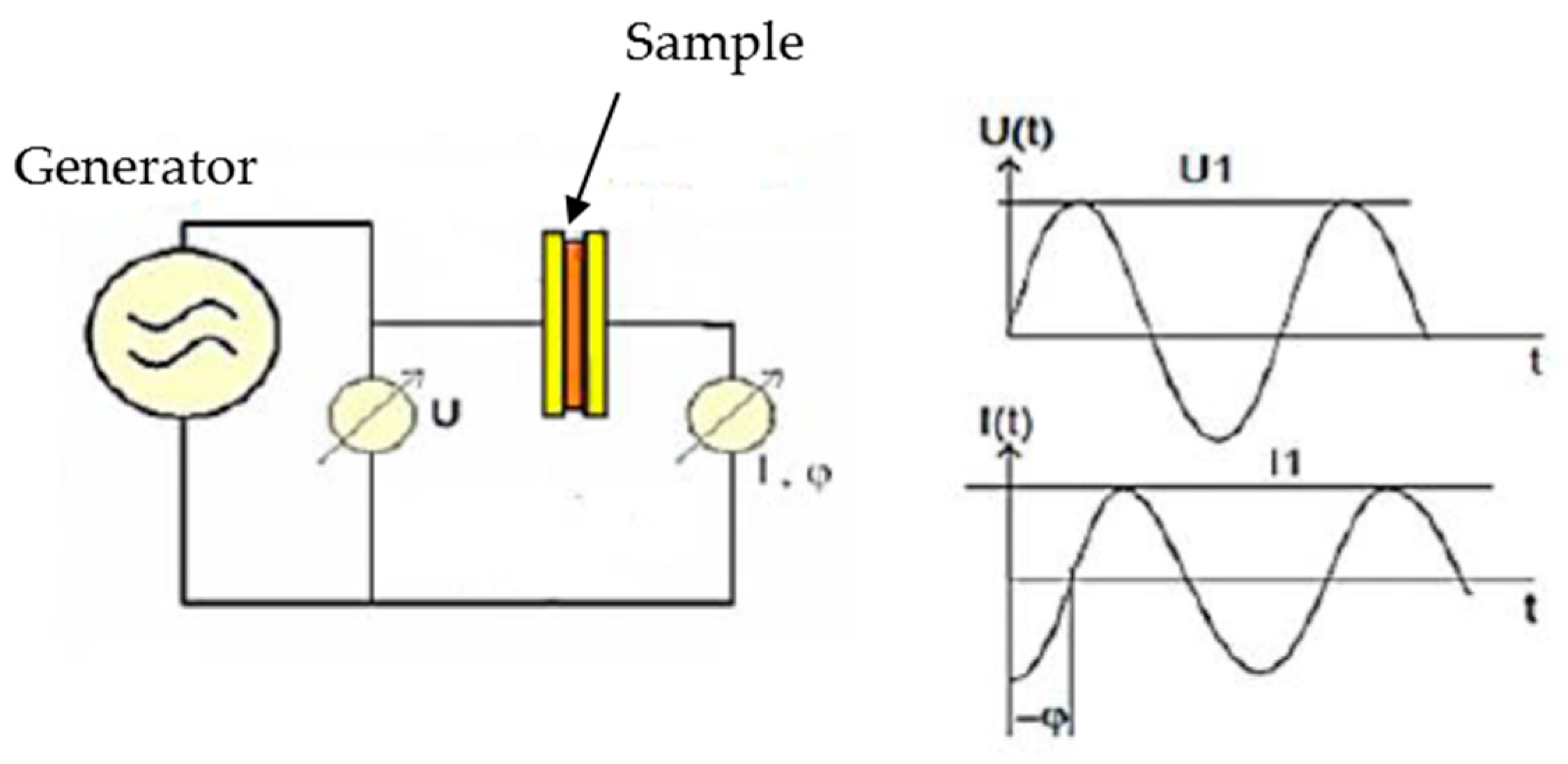

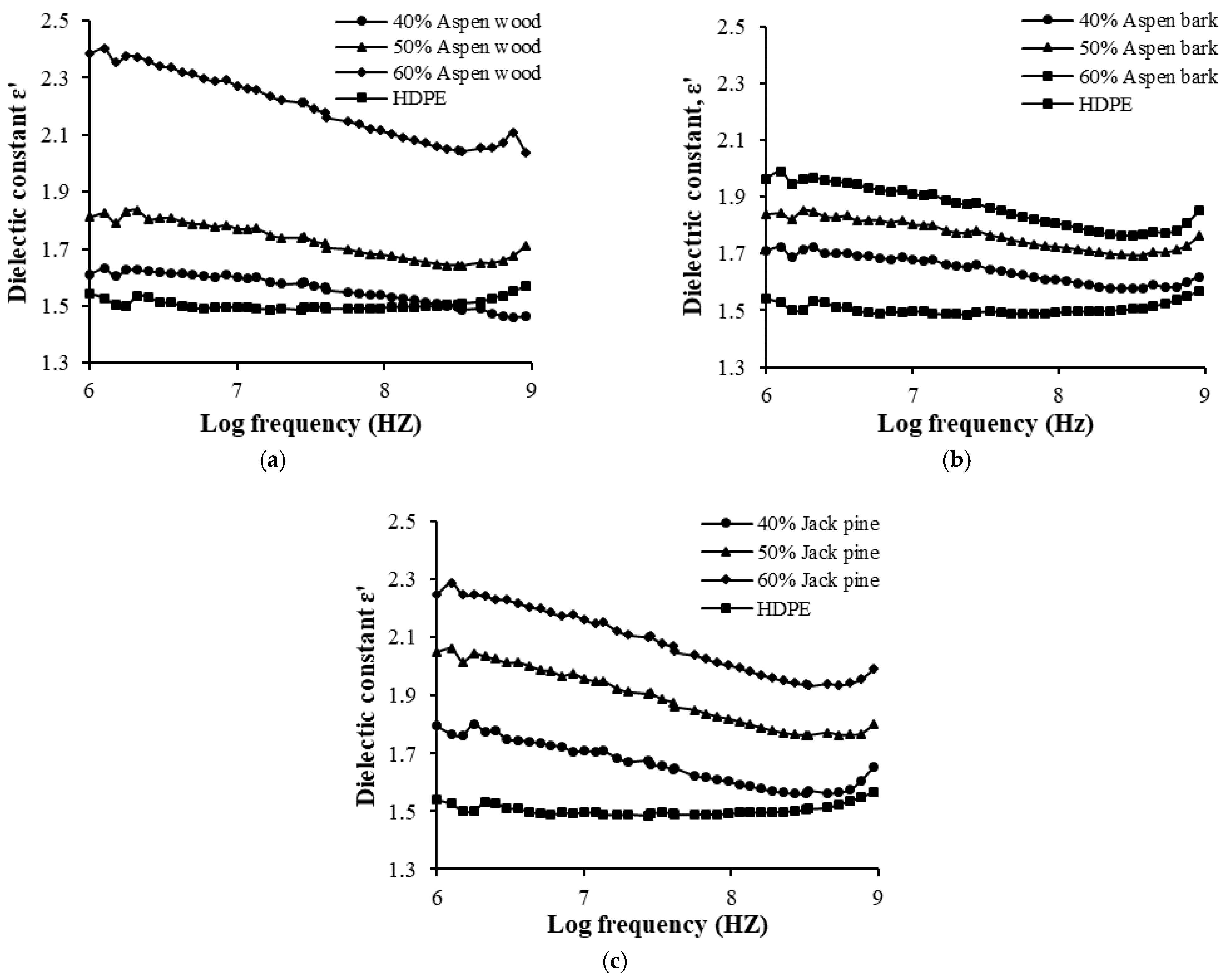
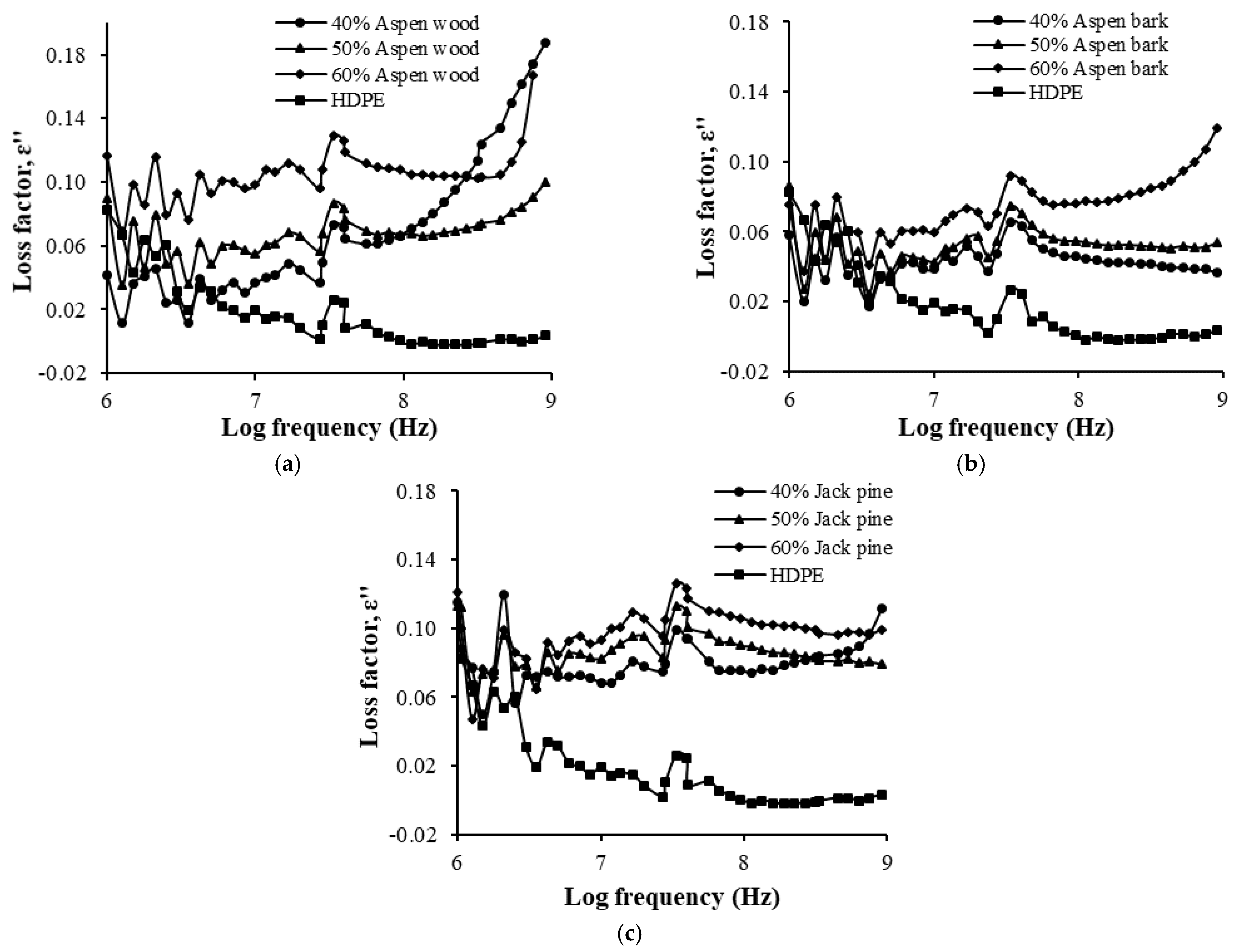
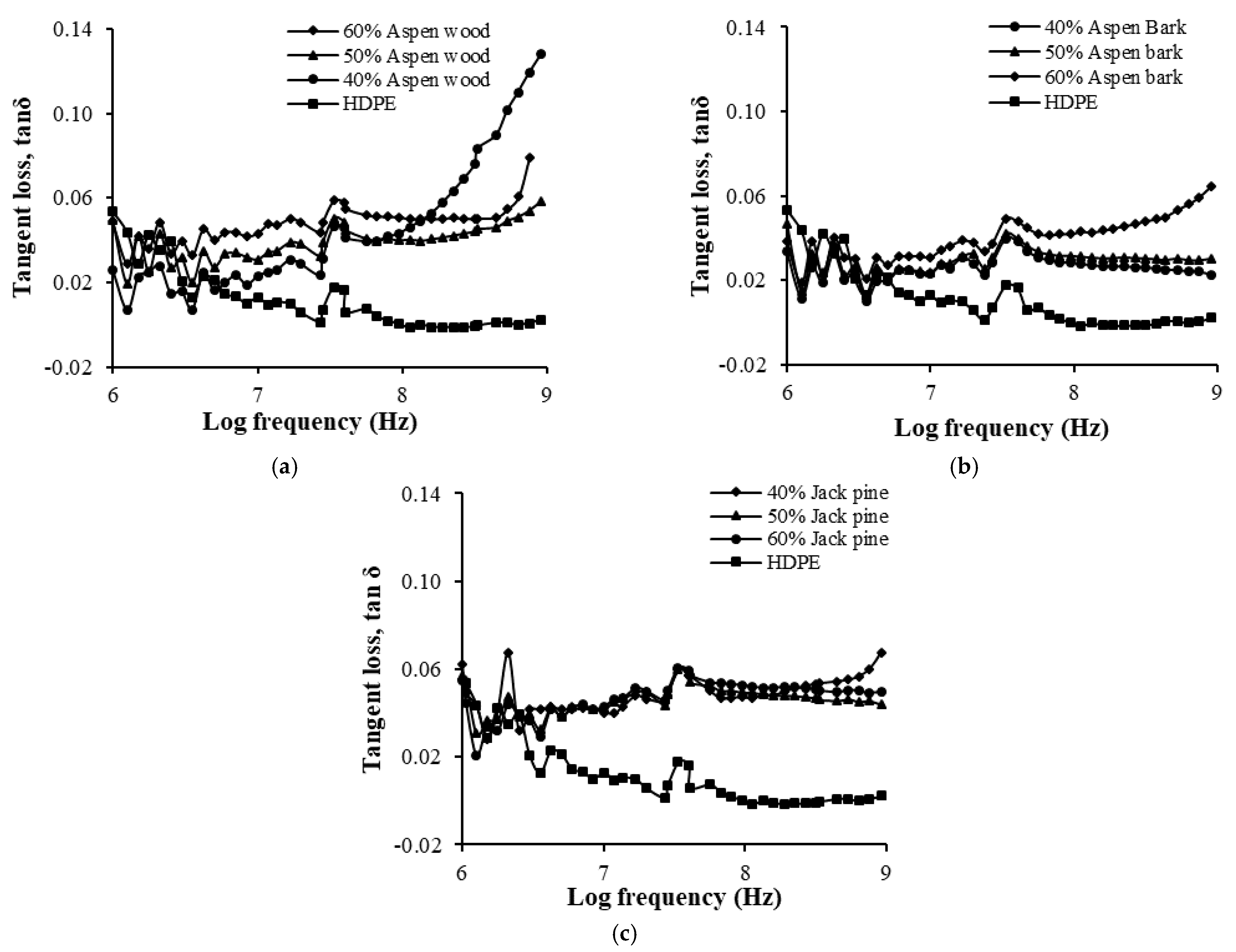
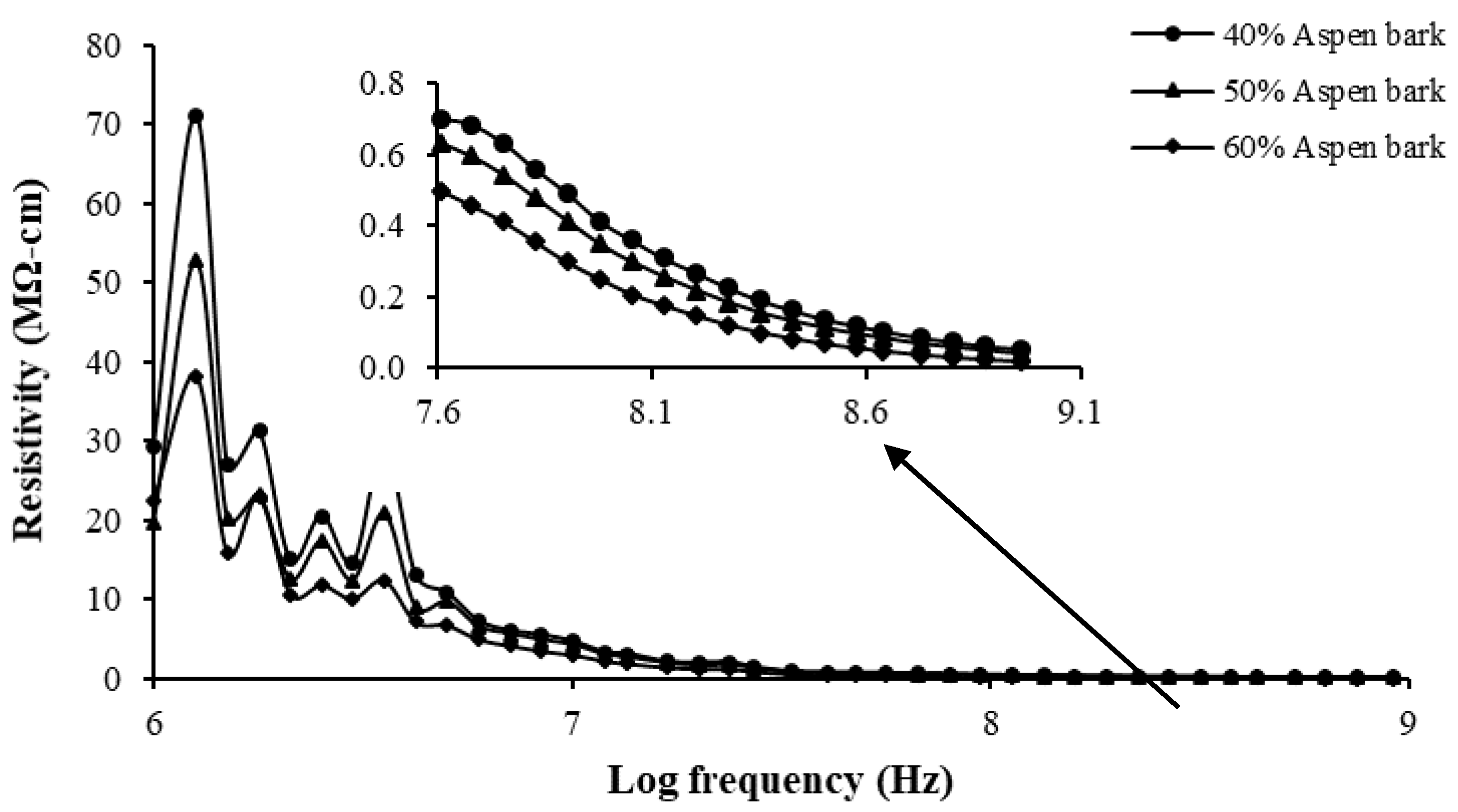

| Particle Type | Content (%) | Cellulose (%) | ||
|---|---|---|---|---|
| Fiber | HDPE | MAPE | ||
| HDPE | 0 | 100 | 0 | 0.0 |
| Jackpine wood | 40 | 57 | 20.8 | |
| 50 | 47 | 3 | 26.0 | |
| 60 | 37 | 31.2 | ||
| Aspen wood | 40 | 57 | 20.3 | |
| 50 | 47 | 3 | 25.4 | |
| 60 | 37 | 30.4 | ||
| Aspen bark | 40 | 57 | 12.80 | |
| 50 | 47 | 3 | 16.00 | |
| 60 | 37 | 19.20 | ||
| Source of Variation | ε′ | ε″ | tan δ | ρ |
|---|---|---|---|---|
| Fiber type (T) | 74.3 ** | 22.0 ** | 23.3 ** | 14.4 ** |
| Proportion (P) | 1031.6 ** | 18.8 ** | 8.6 ** | 4.98 * |
| Frequency (F) | 72.6 ** | 3.5 * | 5.6 ** | 101.4 ** |
| T × P | 104.3 ** | 2.6 n.s. | 3.4 * | 1.6 n.s. |
| T × F | 3.1 * | 1.8 n.s. | 2.0 n.s. | 8.98 ** |
| P × F | 2.4 * | 0.76 n.s. | 0.9 n.s. | 2.9* |
Publisher’s Note: MDPI stays neutral with regard to jurisdictional claims in published maps and institutional affiliations. |
© 2021 by the authors. Licensee MDPI, Basel, Switzerland. This article is an open access article distributed under the terms and conditions of the Creative Commons Attribution (CC BY) license (https://creativecommons.org/licenses/by/4.0/).
Share and Cite
Elloumi, I.; Koubaa, A.; Kharrat, W.; Bradai, C.; Elloumi, A. Dielectric Properties of Wood-Polymer Composites: Effects of Frequency, Fiber Nature, Proportion, and Chemical Composition. J. Compos. Sci. 2021, 5, 141. https://doi.org/10.3390/jcs5060141
Elloumi I, Koubaa A, Kharrat W, Bradai C, Elloumi A. Dielectric Properties of Wood-Polymer Composites: Effects of Frequency, Fiber Nature, Proportion, and Chemical Composition. Journal of Composites Science. 2021; 5(6):141. https://doi.org/10.3390/jcs5060141
Chicago/Turabian StyleElloumi, Imen, Ahmed Koubaa, Wassim Kharrat, Chedly Bradai, and Ahmed Elloumi. 2021. "Dielectric Properties of Wood-Polymer Composites: Effects of Frequency, Fiber Nature, Proportion, and Chemical Composition" Journal of Composites Science 5, no. 6: 141. https://doi.org/10.3390/jcs5060141
APA StyleElloumi, I., Koubaa, A., Kharrat, W., Bradai, C., & Elloumi, A. (2021). Dielectric Properties of Wood-Polymer Composites: Effects of Frequency, Fiber Nature, Proportion, and Chemical Composition. Journal of Composites Science, 5(6), 141. https://doi.org/10.3390/jcs5060141







